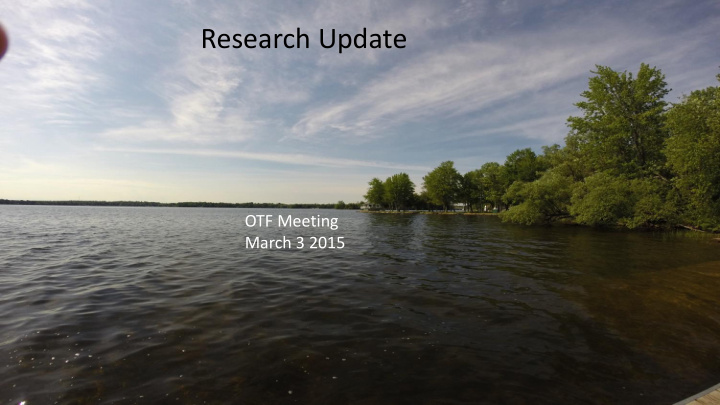



Research Update OTF Meeting March 3 2015
The need for long-term data • Needed to know the magnitude and speed by which humans have altered ecosystems • Needed to set realistic restoration targets 3 Ottawa mean annual temperature deviation from normal (⁰C) 2 Zebra mussels first detected in great lakes in late 80’s 1 Normal (1981-2010) -1 -2 Timeframe of most environmental monitoring programs -3 -4 1890 1895 1900 1905 1910 1915 1920 1925 1930 1935 1940 1945 1950 1955 1960 1965 1970 1975 1980 1985 1990 1995 2000 2005 2010 Nutrient enrichment started to take off in the 50’s and 60’s
Research component of the OTF Research questions: 1) How much have phosphorus and algae concentrations changed from “natural” conditions? Top Present day • Regional assessment of phosphorus and algal change in 20 lakes Bottom Pre-1850 Historical conditions
Research component of the OTF Research component of the OTF Research questions: 2) What are the important controls on algal and macrophyte abundance in eastern Ontario? • Spatial survey of 20 lakes in the RVCA and MVCA watersheds (10 lakes in year 1 and 10 lakes in year 2) • Lakes were selected over a nutrient gradient • Study lakes includes those with and without zebra mussels • Study lakes are part of the CA monitoring programs
Research component of the OTF Research component of the OTF Research questions: 3) Is climate warming related to increased algae and macrophytes? • Detailed sediment core analysis of 3 lakes • Lakes will be selected over a nutrient gradient • Study lakes will have similar size, mean depth, and be part of the CA monitoring program Top Present day Compare inferred TP and algal concentrations in core to historical climate and land use data and the timing of the introduction of invasive species Bottom Pre-1850 Historical conditions
20 study lakes Bobs (Green Bay) Mosque Burridge Malcolm Crosby Shabomeka Bobs (Buck Bay) Clayton Christie Bennett Otty Dalhousie Long Pond Big Gull Tommy (not sampled yet) Kashwakamak Adam Pine Upper Rideau Sharbot (East basin)
73 lakes were cored
Sediment core analysis • 19 of the 20 study lakes have been cored (no core obtained from Tommy lake) • 4 Honours students are working on this project (Diatom IDs complete, data is starting to be analyzed) • Alex Crew • Emily Barrie • Sharon Odongo • Kathryn Sweet
RVCA Top-Bottom study (very preliminary data) Cyclotella spp. Aulacoseria spp Top sediment (present day) Top sediment (present day) 50 60 relative abundance relative abundance 50 40 40 30 30 20 20 10 10 0 0 0 10 20 30 40 50 60 0 10 20 30 40 50 Bottom sediment (~pre-1850) Bottom sediment (~pre-1850) relative abundance relative abundance • Fairly modest change in species assemblages • Some evidence for nutrient enrichment
Otty Lake (Very preliminary diatom data at the genus level) Achnanthes Asterionella Aulacoseira Fragillaria Cyclotella Amphora Navicula • Dominated by small benthic species • Relatively little change species 0 assemblage • Some indication of nutrient enrichment near the top of the core 5 Depth (cm) but work still needs to be done 10 15 20 10 10 10 10 30 10 30 50 70 0 6000 Relative abundance
Macrophyte and algae analysis • 7 study lakes have been sampled • Samples are currently being analyzed • Macrophyte biovolume assessed using echosounder • Colonial algae noted during sampling along with presence of invasive macrophytes
Macrophyte Sampling Light Increasing Biomass Disturbance limited limited DMMB Increasing Water Depth plants plants
Otty Lake submerged aquatic vegetation 60.00% Average plant biovolume 50.00% 40.00% 30.00% 20.00% 10.00% 0.00% 0 2 4 6 8 10 12 Depth (m)
Mosque Lake submerged aquatic vegetation 30% 25% Average plant biovolume 20% 15% 10% 5% 0% 0 2 4 6 8 10 12 Depth (m)
Percent Area Covered by Macrophytes Otty Sharbot 100.00% 90.00% Average area covered (%) 80.00% Mosque 70.00% Adams 60.00% 50.00% 40.00% 30.00% 20.00% Shabomeka 10.00% 0.00% 0-1m 1-2m 2-3m 3-4m 4-5m 5-6m 6-7m 7-8m 8-9m >9m Water depth (m)
Percent Biovolume of Macrophytes (% of water column occupied by plants) 100.00% 90.00% Adams 80.00% 70.00% Biovolume (%) Otty 60.00% 50.00% 40.00% Sharbot 30.00% Mosque 20.00% 10.00% Shabomeka 0.00% 0-1m 1-2m 2-3m 3-4m 4-5m 5-6m 6-7m 7-8m 8-9m >9m Water depth (m)
Orchard lake, Wisconsin Plant Biovolume over 4 years 2011 2012 2013 2014 4-year Average
• Deviation from “normal” • Natural fluctuation in habitat • The role of climate in driving changes 4-year Average
Citizen Water Watch: Website and Smart phone App Purpose: 1) Engage community (including youth) in monitoring the health of lakes and rivers 2) Communication tool: Both between us and the lake users but also among the lake users Where we are: 1) We own the domain name “citizenwaterwatch.ca” (needs to be renewed on an annual basis) 2) Website was up and running last summer (made in Drupal) 3) An Android App is almost up and running and should be available for download in May?
Citizen Water Watch: Website and Smart phone App Purpose: 1) Engage community (including youth) in monitoring the health of lakes and rivers 2) Communication tool: Both between us and the lake users but also among the lake users Where we are: 1) We own the domain name “citizenwaterwatch.ca” (needs to be renewed on an annual basis) 2) Website was up and running last summer (made in Drupal) 3) An Android App is almost up and running and should be available for download in May? Work for this Year: 1) Make the website more engaging: Move to a blog style format with frequent updates and allow registered users to post on certain pages? 2) Move the website from a Drupal format to Wordpress? 3) Get the Android App up and running (An iPhone App is beyond the timeframe and budget of the project)
Smart phone App (Android)
Thank you
Recommend
More recommend